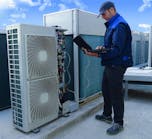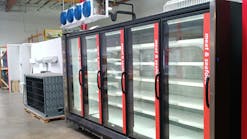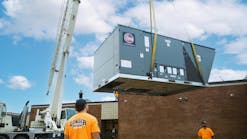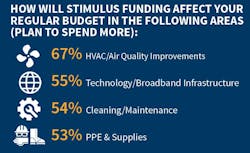UPDATE: American School & University Survey Reveals Administrator Spending Priorities Following COVID-19
STORY HAS BEEN UPDATED WITH DOWNLOADABLE PDF BELOW
A survey of school and university administrators by American School & University reveals significant opportunities for HVAC contracting businesses to begin offering solutions for school HVAC and air quality upgrades.
The American School & University American Rescue Plan Stimulus Survey focused on how school leaders are planning to spend ARP stimulus funding, and which improvements are being prioritized above others. The unequivocal need and interest by administrators for HVAC and indoor air quality upgrades should help to empower HVAC contractors to approach existing or prospective school facility customers with confidence in their role as information sources and solution providers.
Of the 206 respondents to the survey:
- 55 percent are associated with K-12 schools
- 36 percent represent colleges and universities.
- 9 percent include other types of facilities, such as K-8 districts, university law schools and charter schools.
Survey analysts reported these responses closely reflect the percentages of the nation's school districts and higher-education institutions.
Survey results should empower HVAC contractors to approach existing or prospective school facility customers with confidence in their role as information sources and solution providers.
Respondent Responsibilities- 58 percent are facilities, buildings and grounds, and physical plant professionals.
- 10 percent were in charge of their institution's business operations, financing and purchasing
- 7 percent are school superintendents or presidents
- 5 percent were assistant superintendents or vice presidents
- 20 percent of respondents were administrators, directors, planners and other roles.
These titles represent the key decision makers, buyers and specifiers at the nation's schools and universities.
Responses by State
The survey obtained the most responses from:
- California
- Pennsylvania
- New York
- Ohio
- Texas
- Massachusetts
- Florida.
These states represents eight of the Top 10 school districts by enrollment.
CLICK TO OPEN GRAPHIC PRESENTATION OF SURVEY
Stimulus Funding
Seventy percent of respondents said their facilities are eligible for stimulus funding, while a surprising 28 percent said they don't know or are not sure if they are eligible, which indicates that additional education and information sharing is needed to better inform administrators about funding eligibility protocols.
Expected ARP Funding Allocations
- 24 percent of respondents expect to receive between $2.5 to $5 million
- 17 percent expect to receive between $1million and $2.5 million
- 16 percent expect between $10 million to $50 million
- 14 percent expect to receive less than $1 million
- 3 percent are expecting $50 million to $100 million
- 26 percent don’t know or are not sure of what to expect.
Survey analysts reported that with more than 16,000 individual school districts and almost 4,000 higher-education institutions in the United States, the ARP stimulus funds represent a huge funding/spending boost on top of already significant spending by institutions on facilities, upgrade, repair, retrofit, maintenance and operations.
Needs are Critical or Very Important
- 82 percent responded that their facility needs HVAC/air quality improvements
- 74 percent said their facility needs cleaning and maintenance
- 69 percent expressed a need for improved technology and broadband Infrastructure
- 62 percent said their institution needs increased counseling and mental health
- 56 percent need PPE and supplies
- 53 percent responded that their facility needs building envelope upgrades (doors/windows)
- 51 percent said they need new classroom design and furniture.
The same areas schools have identified as needing the most attention also are the areas where the ARP stimulus funds are targeted to provide the most help.
Where Will Stimulus Funding be Allocated?
- 76 percent will allocate funds to HVAC/air quality improvements
- 63 percent will channel funds to cleaning and maintenance
- 53 percent will seek improved technology and/or upgrades to broadband infrastructure
- 44 percent will spend funds on PPE and supplies.
Survey analysts said the interest, need, focus and planned spending on key facilities areas such as HVAC/ventilation/IAQ; cleaning and maintenance, technology, PPE and supplies, etc., is paramount, and where most of the ARP stimulus funding will be applied. Spending in these areas is in addition to billions of dollars annually targeted to these areas via bond issues, capital spending budgets, operating budgets, etc.
Additional Spending Expected
Significant increases in spending in the above areas as a result of ARP stimulus funds is planned by institutions as they prepare their facilities for re-openings and the start of the new school year.
- 67 percent said they plan to spend more on HVAC/Air Quality Improvements
- 55 percent said they will spend more on technology/broadband infrastructure
- 54 percent said they will plan to spend more on cleaning and maintenance
- 53 percent plan to spend more on PPE and supplies
Even with the influx of stimulus money targeted to facilities improvements, modifications and preparing buildings to ensure healthier school environments, institutions still plan to spend on other key areas not specifically benefitting from additional stimulus funding.
- 69 percent of administrators intend to make acoustic upgrades
- 63 percent will make energy efficiency improvements
- 62 percent will make building envelope upgrades, including doors and windows
- 61 percent will seek to erect new buildings and facilities
- 56 percent will pursue classroom design and furniture selection purchases.
Respondents' Roles in Determining How Stimulus Funding Will be Allocated and Implemented
The mix of titles representing the key decision makers at the nation’s education institutions will be instrumental in how the stimulus funding will be targeted and spent, as well as determining the specific products and services that will be specified and purchased.
- 55 percent of respondents have a role in the design and administration of their spending
- 36 percent have a role in specifying products/services
- 35 percent purchase products and services.
- 53 percent will recommend products and services.
Involved Administrators
The level of decision maker Involvement related to technology implementation and infrastructure is very high, with 80 percent of respondents saying they will be involved in decision making and about 30 percent responding they will be very involved.
Quality of Remote Technology
While most institution leaders feel confident in their technology efforts, there are still many that do not consider their technology and cybersecurity efforts to be effective enough, and are in need of improvement.
- In-School Technology (including Bandwidth): 74 percent rated theirs as Excellent/Very Good
- Remote Technology Access for Students: 68 percent rated this as Excellent/Very Good
- Remote Technology Access for Instructional Staff: 69 percent rated this technology as Excellent/Very Good
- Remote Technology Access for Administrative & Support Staff: 71 percent said their tech in this area is Excellent/Very Good
- Cybersecurity: 60 percent rated their cybersecurity as Excellent/Very Good.
Online vs. In-Person Learning
The majority of institutions will continue to primarily operate in-person, with many incorporating some form of online learning. Since most institutions already incorporated online learning in various areas pre-pandemic, it is not clear if the amount of online learning at those institutions is actually increasing or remaining the same as it was pre-pandemic.
- 54 percent responded to say 100% of classes will be held in-person within school buildings
- 40 percent will have a combination of in-person and online learning
- 1 percent will be offering 100 percent virtual/online learning for students with buildings open for non-academic use
- 5 percent have no plan in place for the 2021-2022 school year settings.










